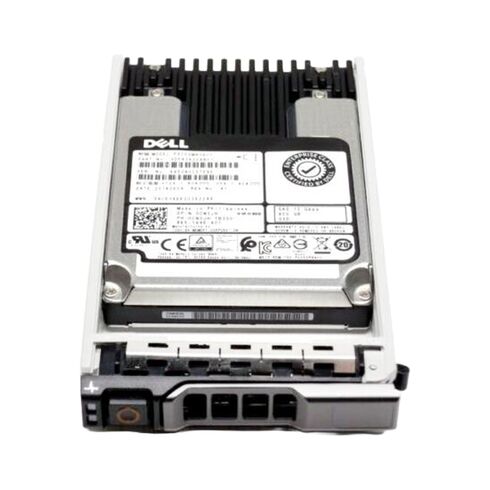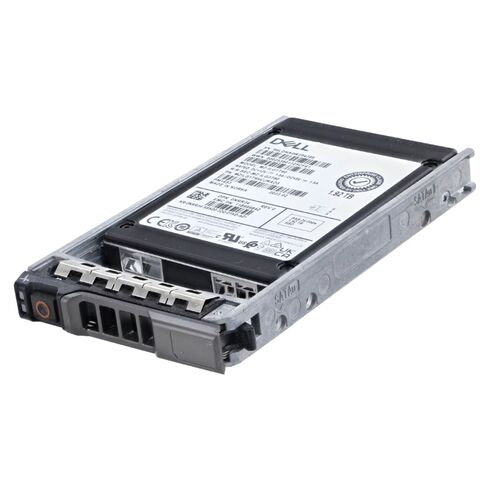Dell 0PX30 1.92TB SAS 12GBPS SSD MLC TLC Hot-Swap External
- — Free Ground Shipping
- — Min. 6-month Replacement Warranty
- — Genuine/Authentic Products
- — Easy Return and Exchange
- — Different Payment Methods
- — Best Price
- — We Guarantee Price Matching
- — Tax-Exempt Facilities
- — 24/7 Live Chat, Phone Support
- — Visa, MasterCard, Discover, and Amex
- — JCB, Diners Club, UnionPay
- — PayPal, ACH/Wire Transfer
- — Apple Pay, Amazon Pay, Google Pay
- — Buy Now, Pay Later - Affirm, Afterpay
- — GOV/EDU/Institutions PO's Accepted
- — Invoices
- — Deliver Anywhere
- — Express Delivery in the USA and Worldwide
- — Ship to -APO -FPO
- — For USA - Free Ground Shipping
- — Worldwide - from $30
Same product also available in:
| SKU/MPN | Warranty | Price | Condition | You save |
|---|---|---|---|---|
| 0PX30 | Six-Month (180 Days) | $378.08 | Excellent Refurbished | You save: $210.52 (36%) |
| 0PX30 | Six-Month (180 Days) | $1,167.40 | New Sealed in Box (NIB) | You save: $655.10 (36%) |
Overview of the DELL Solid State Drive
Product Specifications
- Manufacturer: Dell
- Model Number: 0PX30
Technical Details
- Type: Internal Solid State Drive
- Storage Capacity: 1.92 TB
- NAND Technology: V-NAND TLC
- Form Factor: 2.5 inches x 15 mm SFF
- Interface: SAS-3, SAS 12Gb/s
- Endurance Classification: Mixed Use
- Drive Writes Per Day (DWPD): 3 DWPD
Performance Metrics
- Maximum Sequential Read Speed: 3200 Mbps
- Maximum Sequential Write Speed: 2100 Mbps
Compatibility Information
Supported DELL PowerEdge Servers
- PowerEdge R630
- PowerEdge R730
- PowerEdge R430
- PowerEdge T430
- PowerEdge R230
- PowerEdge R330
- PowerEdge R730xd XL
- PowerEdge R830
- PowerEdge T640
- PowerEdge T440
- PowerVault ME4024
- PowerVault ME424
Technology: Multi-Level Cell (MLC)
Multi-Level Cell (MLC) Technology
Multi-Level Cell (MLC) technology is a type of NAND flash memory technology used in solid-state drives (SSDs) like the Dell 1.92TB SAS 12GBPS Solid State Drive External. MLC technology allows for multiple bits of data to be stored in each memory cell, which increases the storage density and capacity of the SSD.
Benefits of Multi-Level Cell (MLC) Technology
Higher Storage Capacity
One of the key benefits of MLC technology is its ability to store more data in each memory cell. Compared to Single-Level Cell (SLC) technology, which can store only one bit per cell, MLC technology can store multiple bits per cell. This results in higher storage capacity, allowing users to store more data on their SSDs.
Cost-Effective Solution
MLC SSDs are generally more affordable compared to SLC SSDs, making them a cost-effective solution for users looking for high-capacity storage without breaking the bank. The lower cost per gigabyte makes MLC SSDs an attractive option for individuals and businesses alike.
Improved Performance
MLC SSDs offer faster read and write speeds compared to traditional hard disk drives (HDDs). The improved performance translates into faster boot times, quicker application launches, and reduced file transfer times. Whether you are a gamer, content creator, or professional, the speed and responsiveness of an MLC SSD can greatly enhance your overall computing experience.
Durability and Reliability
While MLC technology has traditionally been associated with lower endurance compared to SLC technology, advancements in manufacturing techniques and error correction algorithms have significantly improved the durability and reliability of MLC SSDs. The Dell 1.92TB SAS 12GBPS Solid State Drive External utilizes advanced wear-leveling algorithms and error correction mechanisms to ensure the longevity of the drive.
Interface: SAS 12GBPS
Understanding SAS (Serial Attached SCSI)
Serial Attached SCSI (SAS) is a high-speed data transfer interface used in enterprise storage systems. It combines the benefits of SCSI (Small Computer System Interface) and Serial ATA (SATA) to deliver fast and reliable data transfer rates.
Benefits of SAS 12GBPS
High Data Transfer Rates
The SAS 12GBPS interface provides lightning-fast data transfer rates, allowing for quick access to stored data. Whether you are transferring large files, running resource-intensive applications, or managing a database server, the high data transfer rates of SAS 12GBPS ensure smooth and efficient operations.
Scalability and Compatibility
SAS 12GBPS offers scalability, allowing you to connect multiple drives in a daisy-chain configuration, enabling easy expansion of storage capacity as your needs grow. Additionally, SAS is backward compatible with older SAS and SATA interfaces, ensuring compatibility with existing infrastructure and devices.
Reliability and Redundancy
SAS 12GBPS is designed for enterprise-level reliability and redundancy. It supports features such as error detection and correction, hot-swapping, and dual-port connectivity, ensuring uninterrupted data access and minimizing downtime. These features are crucial for mission-critical applications that require high availability and data integrity.
Enterprise-Grade Performance
SAS 12GBPS is widely used in enterprise storage environments due to its exceptional performance capabilities. It provides low-latency access to data, enabling fast response times for demanding workloads. Whether you are running virtualization, database, or video editing applications, the enterprise-grade performance of SAS 12GBPS ensures smooth and efficient operations.
Use: Mixed Use
Understanding Mixed Use SSDs
Mixed Use (MU) SSDs are designed to meet the demands of both read-intensive and write-intensive workloads. They strike a balance between performance, endurance, and cost-effectiveness, making them suitable for a wide range of applications.
Benefits of Mixed Use SSDs
Versatility
Mixed Use SSDs offer versatility, making them suitable for various use cases. Whether you are a power user requiring high-performance storage for demanding applications, a content creator dealing with large media files, or a business managing virtualized environments, mixed-use SSDs can handle diverse workloads effectively.
Optimized Performance
Mixed Use SSDs are optimized to deliver consistent performance across different types of workloads. They offer a balance between read and write speeds, ensuring smooth and responsive operations. This makes them ideal for applications that require both fast data access and efficient data storage.
Cost-Effective Solution
Mixed Use SSDs provide a cost-effective solution for users who require higher endurance than consumer-grade SSDs but do not need the extreme durability of enterprise-grade SSDs. They offer a balance between price and performance, making them an attractive option for individuals and businesses looking for reliable storage without excessive costs.
HotSwap: 1
Understanding HotSwap Technology
HotSwap technology allows for the removal or insertion of drives without shutting down the system. It enables seamless drive replacement or expansion, minimizing downtime and ensuring uninterrupted operations.
Benefits of HotSwap Technology
Easy Maintenance and Upgrades
HotSwap technology simplifies drive maintenance and upgrades by allowing for effortless removal and replacement of drives. This is particularly beneficial in enterprise environments where system downtime can result in significant financial losses. With HotSwap, IT administrators can replace or upgrade drives on the fly, minimizing disruptions and maximizing productivity.
Improved Data Availability
By supporting hot-swapping, HotSwap technology ensures continuous data availability. In the event of a drive failure, a hot-swappable drive can be replaced immediately, reducing the risk of data loss and minimizing the impact on operations. This feature is crucial for applications that require high availability and data redundancy.
Flexibility and Scalability
HotSwap technology allows for easy scalability of storage systems. Drives can be added or removed without interrupting the operation of the system, enabling seamless expansion or reconfiguration of storage capacity. This flexibility is essential for businesses experiencing rapid growth or those that need to adapt to changing storage requirements.
PartNumber: 0PX30
Understanding Part Numbers
Part numbers are unique identifiers assigned to specific products to facilitate identification and ordering. They provide a standardized way to reference and differentiate between different variations or versions of a product.
Benefits of Part Numbers
Accurate Product Identification
Part numbers ensure accurate product identification, allowing users to easily find and order the exact product they require. By referencing the specific part number, users can avoid confusion or potential mistakes when purchasing or replacing components.
Compatibility Assurance
Part numbers also help ensure compatibility between components. Manufacturers assign specific part numbers to different variations or versions of a product, indicating any differences in specifications or features. By referencing the correct part number, users can be confident that the component they are purchasing is compatible with their existing system.
Efficient Inventory Management
Part numbers play a crucial role in inventory management for manufacturers, suppliers, and retailers. By assigning unique part numbers to each product, businesses can track and manage their inventory more efficiently. This helps streamline the supply chain and ensures accurate stock levels, reducing the risk of shortages or overstocking.










